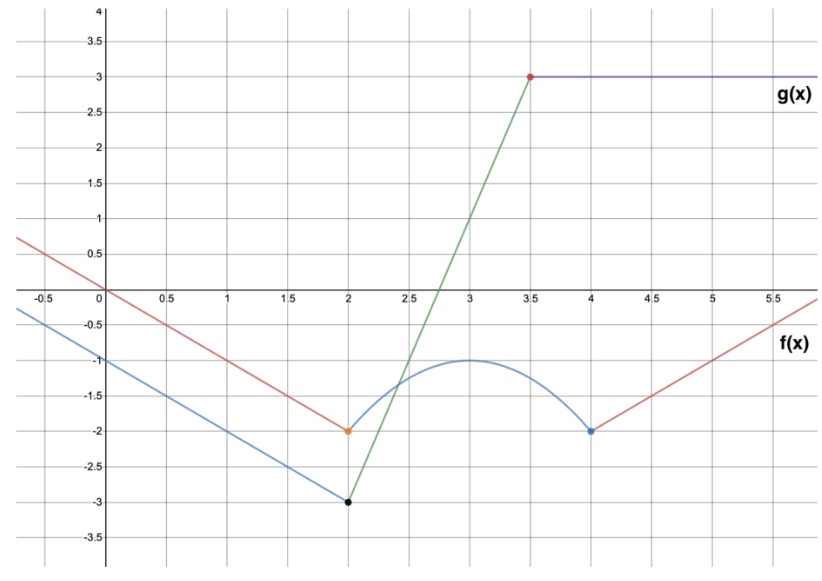Given that h(x) = f(g(x)), use the graphs of f(x) and g(x) to find h'(3). -0.5 [A] 0 3.5 3 2:5 2 1.5 1 -0.5 0 -0.5 --1 -1.5- -2 -2.5- -3 --3:5 [B] -4 0.5 [C] -1 1.5 2 [D] -2 2.5 3 3.5 4 4.5 5 [E] h is not differentiable at x = 3. g(x) 5.5 f(x)
Given that h(x) = f(g(x)), use the graphs of f(x) and g(x) to find h'(3). -0.5 [A] 0 3.5 3 2:5 2 1.5 1 -0.5 0 -0.5 --1 -1.5- -2 -2.5- -3 --3:5 [B] -4 0.5 [C] -1 1.5 2 [D] -2 2.5 3 3.5 4 4.5 5 [E] h is not differentiable at x = 3. g(x) 5.5 f(x)
Calculus: Early Transcendentals
8th Edition
ISBN:9781285741550
Author:James Stewart
Publisher:James Stewart
Chapter1: Functions And Models
Section: Chapter Questions
Problem 1RCC: (a) What is a function? What are its domain and range? (b) What is the graph of a function? (c) How...
Related questions
Question
![### Problem Statement
**Given that \( h(x) = f(g(x)) \), use the graphs of \( f(x) \) and \( g(x) \) to find \( h'(3) \).**
### Graphs and Analysis
The graph contains two plotted functions: \( f(x) \) and \( g(x) \).
- **\( f(x) \)**
- Depicted by the red line, \( f(x) \) is a piecewise linear function.
- The slope transitions at different intervals, notably with a negative slope initially and then a change of slope nearing \( x = 3.5 \).
- **\( g(x) \)**
- Illustrated by the green line, \( g(x) \) starts increasing sharply and becomes a constant line parallel to the x-axis after \( x = 3.5 \).
### Calculating \( h'(3) \)
To find \( h'(3) \), we use the chain rule:
\[ h'(x) = f'(g(x)) \cdot g'(x) \]
1. **Find \( g(3) \):**
- At \( x = 3 \), the graph indicates \( g(3) = 1.5 \).
2. **Compute \( g'(3) \):**
- The slope of \( g(x) \) at \( x = 3 \) remains positive (the line rises steeply). The graph segment's slope provides \( g'(3) \approx 2 \).
3. **Find \( f'(g(3)) = f'(1.5) \):**
- On inspecting \( f(x) \) at \( x = 1.5 \), the slope \( f'(1.5) \) appears constant on the negative slope, approximately \(-1\).
4. **Apply the chain rule:**
\[
h'(3) = f'(1.5) \cdot g'(3) = (-1) \cdot 2 = -2
\]
### Conclusion
The correct answer for \( h'(3) \) is \(-2\).
**Answer Choices:**
- [A] 0
- [B] \(-4\)
- [C] \(-1\)
- [D] \(-2\)
- [E] \( h \text{ is](/v2/_next/image?url=https%3A%2F%2Fcontent.bartleby.com%2Fqna-images%2Fquestion%2F93724627-c7b6-406b-9a00-d0dcd2c570ce%2F3c40ed87-5b2f-4679-87c5-18afdfa81229%2Fzy50kr6_processed.png&w=3840&q=75)
Transcribed Image Text:### Problem Statement
**Given that \( h(x) = f(g(x)) \), use the graphs of \( f(x) \) and \( g(x) \) to find \( h'(3) \).**
### Graphs and Analysis
The graph contains two plotted functions: \( f(x) \) and \( g(x) \).
- **\( f(x) \)**
- Depicted by the red line, \( f(x) \) is a piecewise linear function.
- The slope transitions at different intervals, notably with a negative slope initially and then a change of slope nearing \( x = 3.5 \).
- **\( g(x) \)**
- Illustrated by the green line, \( g(x) \) starts increasing sharply and becomes a constant line parallel to the x-axis after \( x = 3.5 \).
### Calculating \( h'(3) \)
To find \( h'(3) \), we use the chain rule:
\[ h'(x) = f'(g(x)) \cdot g'(x) \]
1. **Find \( g(3) \):**
- At \( x = 3 \), the graph indicates \( g(3) = 1.5 \).
2. **Compute \( g'(3) \):**
- The slope of \( g(x) \) at \( x = 3 \) remains positive (the line rises steeply). The graph segment's slope provides \( g'(3) \approx 2 \).
3. **Find \( f'(g(3)) = f'(1.5) \):**
- On inspecting \( f(x) \) at \( x = 1.5 \), the slope \( f'(1.5) \) appears constant on the negative slope, approximately \(-1\).
4. **Apply the chain rule:**
\[
h'(3) = f'(1.5) \cdot g'(3) = (-1) \cdot 2 = -2
\]
### Conclusion
The correct answer for \( h'(3) \) is \(-2\).
**Answer Choices:**
- [A] 0
- [B] \(-4\)
- [C] \(-1\)
- [D] \(-2\)
- [E] \( h \text{ is
Expert Solution
Step 1
Given that h(x) = f(g(x))
The graph of f(x) and g(x) is given as

Step by step
Solved in 2 steps with 1 images

Recommended textbooks for you

Calculus: Early Transcendentals
Calculus
ISBN:
9781285741550
Author:
James Stewart
Publisher:
Cengage Learning

Thomas' Calculus (14th Edition)
Calculus
ISBN:
9780134438986
Author:
Joel R. Hass, Christopher E. Heil, Maurice D. Weir
Publisher:
PEARSON

Calculus: Early Transcendentals (3rd Edition)
Calculus
ISBN:
9780134763644
Author:
William L. Briggs, Lyle Cochran, Bernard Gillett, Eric Schulz
Publisher:
PEARSON

Calculus: Early Transcendentals
Calculus
ISBN:
9781285741550
Author:
James Stewart
Publisher:
Cengage Learning

Thomas' Calculus (14th Edition)
Calculus
ISBN:
9780134438986
Author:
Joel R. Hass, Christopher E. Heil, Maurice D. Weir
Publisher:
PEARSON

Calculus: Early Transcendentals (3rd Edition)
Calculus
ISBN:
9780134763644
Author:
William L. Briggs, Lyle Cochran, Bernard Gillett, Eric Schulz
Publisher:
PEARSON

Calculus: Early Transcendentals
Calculus
ISBN:
9781319050740
Author:
Jon Rogawski, Colin Adams, Robert Franzosa
Publisher:
W. H. Freeman


Calculus: Early Transcendental Functions
Calculus
ISBN:
9781337552516
Author:
Ron Larson, Bruce H. Edwards
Publisher:
Cengage Learning